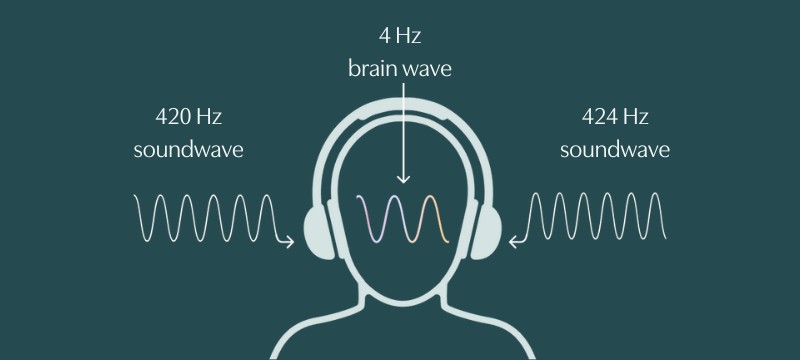Guided meditations are a popular way to find calm and improve mental well-being. But what if you prefer a more independent approach? Maybe you find the voices distracting, or perhaps you’re looking for meditation techniques that transcend language barriers. If you’re searching for “How To Meditate Without A Guide,” you’re in the right place. Fortunately, many effective alternatives exist that allow you to deepen your calm and experience the benefits of meditation without relying on external guidance.
Here are five simple yet powerful ways to meditate without a guide:
1. Immerse Yourself in Meditones®
Meditones® offer a unique, effortless path to meditation. They require no active participation, allowing you to reap the rewards of deep meditation passively. Meditones combine binaural beats with soothing ambient music to gently guide your brain into a state of tranquility. Simply listen with headphones and let the experience unfold.
Meditones are particularly beneficial for:
- Beginners: A gentle introduction to meditation.
- Pain Relief: Can help alleviate discomfort.
- Fatigue: Ideal when you’re too tired for traditional methods.
- Overstimulation: Perfect for calming distress and sensory overload.
- Neurodiversity: Accessible for autistic, ADHD, and other neurodivergent individuals who may find guided meditations challenging.
Meditones offer an accessible and effective way to meditate without guidance. You can also combine them with the techniques below to enhance your meditation experience.
Explore a growing library of Meditones with the Restful app. Download it for free on Google Play or the App Store today!
2. Focus on Your Exhale
Conscious breathing is a powerful tool for independent meditation. Deep breathing helps focus your mind and relax your body. Breathwork activates the parasympathetic nervous system (PNS), promoting a sense of calm.
A simple breathing technique is 2-1 Breathing, where you exhale for twice as long as you inhale. For example, inhale for a count of two and exhale for a count of four.
Alternatively, simply extend your exhale without counting. Take a deep breath in, gently puff out your cheeks, and exhale slowly, noticing the release of tension in your muscles. Repeat these breathing techniques as needed to deepen your relaxation. This focused breath awareness is a cornerstone of learning how to meditate without a guide.
3. Practice Body Scan Meditation
Body scan meditation enhances body awareness and helps release unnoticed tension. By systematically scanning your body from your feet to your head, you bring mindful attention to each area, promoting relaxation and letting go.
To begin a body scan:
- Bring your attention to your feet.
- Notice any sensations present.
- Pay attention to areas of tension or stiffness.
- Acknowledge areas that feel calm or neutral.
- Breathe deeply and consciously relax your feet.
Repeat this process, moving through your:
- Legs
- Hips
- Torso
- Hands
- Arms
- Neck
- Face and Head
Use your breath to release any pain, tension, or intense emotions. Also, acknowledge and appreciate any comfortable sensations. Releasing tension allows rest for both mind and body. Regularly practicing a body scan is a great skill when learning how to meditate without a guide.
4. Repeat a Calming Phrase
Mantras, affirmations, or calming phrases can focus the mind and provide a sense of inner peace. You don’t need a special mantra from a teacher; simply choose a phrase that resonates with you and evokes a sense of calm.
Simple statements like “I am safe” or “Here Now” are excellent examples.
You can repeat these phrases aloud or silently in your mind. You can also synchronize the phrase with your breath, inhaling the word “Here” and exhaling the word “Now.”
It’s normal for your mind to wander during meditation. When you notice your thoughts drifting, gently redirect your focus back to your calming phrase.
5. Cultivate a Positive Emotion
Our brains often blur the lines between reality and imagination. Just as books, movies, and music evoke emotions, you can deliberately create a feeling by focusing on it.
You can cultivate joy, peace, or even euphoria. Your brain won’t distinguish between a spontaneous emotion and one you intentionally create.
How do you want to feel? Choose the positive emotion you want to cultivate.
Recall the sensations associated with that emotion. Do your eyes feel brighter when you feel euphoric? Do your shoulders feel heavy when you feel calm?
As you begin to feel your chosen emotion, amplify it with deep breaths. Explore the depth and intensity of the feeling, riding the waves and savoring each moment. This can be a powerful and rewarding approach to meditation, offering an alternative to guided practices. This is a powerful method for learning how to meditate without a guide.
The Freedom of UnGuided Meditation
You don’t need guided meditations to experience the benefits of meditation. There are numerous simple techniques you can use to meditate independently. Many of these practices can be done quietly, anywhere, and anytime, giving you the freedom to find calm whenever you need it. Learning how to meditate without a guide gives you control and flexibility.
Find your calm, your way with the Restful app. Download for free on Google Play or the App Store today!
